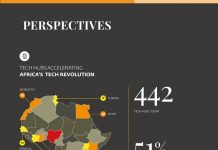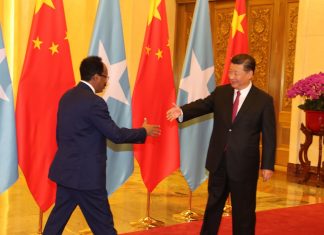The world seems to be fascinated by African culture and design. So why isn’t the fashion industry on the continent blowing Paris out of the water? The issue is as complex as the patterns of African prints.
While there is growing interest in African fashion and African fashion designers based in Europe and North America, designers within Africa are still trying to find a sustainable market locally. Some are thriving, however.
“There are many designers based in Africa,” says Stephen Manzini, founder of Soweto Fashion Week. “However, growth is slow.”
Adiat Disu, president of Adirée and director of Africa Fashion Week in New York City, adds: “There are quite a few designers operating directly out of Africa. At least 50 percent to 75 percent of our designers who showcase in New York’s Africa Fashion Week come from Africa. Equally important are the many designers based in the UK and U.S. who outsource to Africa, working with African designers, tailors, and seamstresses back home.”
Disu, a native of Nigeria, founded Adirée to focus on rebranding Africa as a destination for luxury brands. Adirée’s efforts to date have generated $100,000 in financing for African designers and artisans to showcase in the United States. The firm’s premier event, Africa Fashion Week, attracts more than 1,500 industry insiders.
One designer making a go of it in Africa is Ally Rehmtullah, based in Dar-es-Salaaam, Tanzania. Rehmtullah studied graphics and design in the United States, but his advisor at the Baum School of Art, in Allentown, Pennsylvania, discerned a sense of fashion in him and convinced him to take a few fashion classes.
“After that there was no going back,” Rehmtullah says. He launched his fashion business in Tanzania in 2007 and today he is recognized as one of the most successful designers not only in Tanzania, but also in all of East Africa.
Rehmtullah sees growing interest in both African fashion and the overall industry. “The interest in African design was always there but before, due to the lack of exposure, it was difficult for us to realize its potential. Now, with the Internet and TV, we see the interest that the African fashion industry has for the Western market. Plenty of Western designers are now trying to use African prints in their work,” explains Rehmtullah.
Opportunities have also increased in Africa, although there is much room for improvement.
“Comparing my life and my career six years ago and today, there is a huge difference,” says Rehmtullah. “Before it was very difficult for fashion designers to find a platform to showcase their work, but today we have platforms like Swahili Fashion Week in Tanzania, Kenya Fashion week in Kenya, and all these are platforms for young designers to come out and showcase their work. They are seeing the potential in the industry and everyone in the industry wants to promote. This wasn’t the case five years ago. This is a proof that the fashion industry is growing, and this is just the beginning.”
But there are still many challenges for African designers in Africa, one of them being Chinese domination of the textile industry, says Manzini. Even the equipment used in the industry is imported from Asia and Eastern Europe. “Governments are trying to assist African designers but I think they can do more by putting up trade barriers against the Chinese so our locals can prosper, too,” he says.
As an African designer based in Tanzania the challenges are plenty, Rehmtullah asserts. Among the major ones is the unavailability of fabrics. “Even though cotton is the second largest export product in Tanzania, textiles still are not produced in Tanzania. Raw cotton is exported to different countries like China, where it is processed into finished goods and then brought back to Tanzania where we have to buy our own cotton at thrice the price. Hence it becomes expensive to work under those circumstances.”
Lack of an international presence is also a big headache. “We see our fabric, our textiles and our prints being showcased in the international market by Western designers and we can’t say anything,” Rehmtullah complains. “For example, in 2007 I launched a line using the Maasai fabric. In 2009 Louis Vuitton launched a similar line for men using the Maasai fabrics and probably made thousands of dollars out of that collection. This is not fair on us, but due to lack of international exposure we can’t do anything about that.”
Industry-related education is another major challenge. “East Africa is known for one of the best universities in the region, but none of these universities offers a fashion program. They do not see a need for it. And if the government doesn’t see a need for the fashion industry locally, it becomes difficult for us to convince the international market of our existence,” Rehmtullah laments.
Some designers in Africa are getting help from outside. “A few designers that we personally have worked with are Fikirte and Mafi from Ethiopia. Through our sustainable partnership with USAID: East Africa Trade Hub, Fikirte and Mafi were financially supported and able to enter the New York Market,” explains Disu.
Fikirte took first place at a Mauritius event, which secured her entry to African Fashion Week in New York and led her to Paris in 2012 and an alliance with Adirée. The designer uses local fabrics and traditional Ethiopian weavers. She is committed to strengthening the skills of her weavers, and consistently provides them with high-end work for which she pays them well.
By exporting to the United States through the African Growth and Opportunity Act, which allows duty-free entry to U.S. markets, Fikirte is able to generate the demand she needs to fulfill her commitment to her weavers. USAID’s East Africa Trade Hub connected her with an experienced AGOA exporter, Wambui Njogu, and sponsored her for fashion shows attended by U.S. and international buyers.
Still, more African designers are thriving outside of Africa than designers at home. “African designs are more in demand outside of Africa, they are more on a fast track than those in Africa,” says Manzini.
Disu agrees. “You’re seeing the promotion of Africa fashion outside of Africa begin to heighten interest and fascinate individuals vis a vis Africa and its propensity to produce quality brands, and for its potential from an interactive marketing standpoint,” she says.
On as well as off the continent, Africa’s fashion industry needs to have various promotional efforts — traditional as well as digital, strategic initiatives of mutual benefit to stakeholders, and supply chains and distribution networks that connect and inspire creativity and innovation in order to develop, Disu says .
The industry has great potential. Africa’s global ranking may be low but cultural colors and clothing are increasingly being embraced globally, Manzini says.
The potential market in Africa is huge both in terms of size and value. South Africa and Nigeria currently are the continent’s top fashion markets, but other countries, such as Ethiopia and Mauritius, are on the rise. “With 900 million potential customers, why wouldn’t the world be interested in tapping into such a market?” Disu says.
While many parts of the world were experiencing economic crises, Africa had six of the 10 top performing economies in the decade through 2010 and is expected to claim seven of the top ten by 2015, exceeding the growth rates of developed countries. “If Africa continues to grow at such a rate, consumers will buy $1.4 trillion worth of goods and services by 2020,” Disu says, referring to World Bank projections for consumer spending.
Lesotho, Kenya, Mauritius and Swaziland (in that order) are the leaders in terms of textile and apparel exports. Exports from the continent as a whole are low, as it is still a developing industry. But more production hubs are coming on stream, with Mauritius, Ethiopia and Ghana leading the way. Mauritius alone accounts for 66 percent of African textile and clothing imports into South Africa. Mozambique, Angola and Ethiopia are also seeing an increase in African textile factories.
If African governments were to throw their support behind the fashion industry, the possibilities would be enormous. Indeed, it will take a joint effort to get the African fashion industry up to speed, Disu says.
“More organizations must work with African countries’ respective law centers and organizations like the African Cotton and Textile Industries Federation to build more institutional capacity in the region, identify key trade policy issues that limit exports of textiles and apparel, and to advocate for reforms that liberalize trade within the region, and with the U.S.,” she says.
At present, the industry is a loose amalgam of African designers worldwide, creative professionals, non-government organizations, small to medium-sized businesses, chambers of commerce, and others who are interested in the successful promotion and formal establishment of an African fashion industry. While African designers can become famous and successful on the continent, those who are most competitive and who are garnering more support are the ones who are able to travel globally, specifically to fashion capitals like New York.
“What buyers, the press, and fashion enthusiasts need is a bridge to discover these African designers and to discover and increase [related] trade and investment opportunities,” says Disu.













